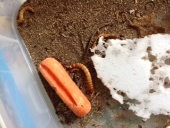








 3
3




Freedom!
 3
3




"The highest function of ecology is the understanding of consequences."
"Cultivate gratitude; hand out seed packets"
 3
3




 1
1




Find me at http://www.powellacres.com/
 2
2




The holy trinity of wholesomeness: Fred Rogers - be kind to others; Steve Irwin - be kind to animals; Bob Ross - be kind to yourself




"People may doubt what you say, but they will believe what you do."








Guerric Kendall wrote:But how are you planning on getting them to eat it?
"People may doubt what you say, but they will believe what you do."




Todd Parr wrote:I have no scientific (or other) evidence for my stance, but I can tell you that I raise large numbers of mealworms to feed other animals and no way I'm feeding mine styrofoam. I have a special mix of food I feed mine on because I want to ensure that they have those nutrients available for the animals that eat them. I look at it like this. Suppose I could eat glass. My system could break it down and use it with no problems. I can't believe I would get any nutritional value from it, and I can't believe that styrofoam has any nutritional value either. Even if they can break it down into completely, 100% inert ingredients, which it doesn't sound like to me, I don't think they can be getting any nutritional value from it. At best, you are using mealworms to break down the styrofoam at their expense, and passing the mealworms without nutritional value to the animal down the food chain.




A human being should be able to change a diaper, plan an invasion, butcher a hog, conn a ship, design a building, write a sonnet, balance accounts, build a wall, set a bone, comfort the dying, take orders, give orders, cooperate, act alone, solve equations, analyze a new problem, pitch manure, program a computer, cook a tasty meal, fight efficiently, die gallantly. Specialization is for insects.
-Robert A. Heinlein












Freedom!








 1
1




Guerric Kendall wrote:... But how are you planning on getting them to eat it? Having raised mealworms in styrofoam containers, without them ever damaging it, I think asking whether it renders them inedible is getting ahead of ourselves here. I've seen this come up from time to time as in this thread here, but have yet to actually see anybody get them to eat it.
Freedom!
 2
2




Todd Parr wrote:I have no scientific (or other) evidence for my stance, but I can tell you that I raise large numbers of mealworms to feed other animals and no way I'm feeding mine styrofoam. I have a special mix of food I feed mine on because I want to ensure that they have those nutrients available for the animals that eat them. I look at it like this. Suppose I could eat glass. My system could break it down and use it with no problems. I can't believe I would get any nutritional value from it, and I can't believe that styrofoam has any nutritional value either. Even if they can break it down into completely, 100% inert ingredients, which it doesn't sound like to me, I don't think they can be getting any nutritional value from it. At best, you are using mealworms to break down the styrofoam at their expense, and passing the mealworms without nutritional value to the animal down the food chain.
Blazing trails in disabled homesteading
 1
1




 4
4




Thomas Tersigni wrote:Mealworms do in fact get the same amount of nutrition from styrofoam as they would from any other food, because styrofoam is made of the same basic building blocks as food. Which is Carbon, Hydrogen, and some other impurities, and the bacteria in the gut biome of the mealworms is actually capable of using the energy from breaking the chemical bonds as a direct form of life sustaining energy, that is why if you feed a mealworm styrofoam, it is just as healthy as if you fed it some fancy mealworm mix. I have designed a system, a sort of factory process, per se, that could be implemented one city at a time, and uses mealworms to completely breakdown styrofoam into biological wast, i.e. poop. It breaks down essentially every single bit of styrofoam, as the Styrofoam is actually cycled through the system again and again to reach 100 percent waste reduction. If anybody would like to talk to me about this please let me know! My email is keeperofthefun24@gmail.com, and my phone number is 9712000831. I actually would love for others to become involved with what I am doing, so please, please, please reach out if you have any questions!
A build too cool to miss:Mike's GreenhouseA great example:Joseph's Garden
All the soil info you'll ever need:
Redhawk's excellent soil-building series






|
I met your mom on a Carribean cruise and she said you would help me and this tiny ad:
Play Your Way to a Sustainable Lifestyle: Uncover Permaculture Principles with Each Card
https://gardener-gift.com/
|







